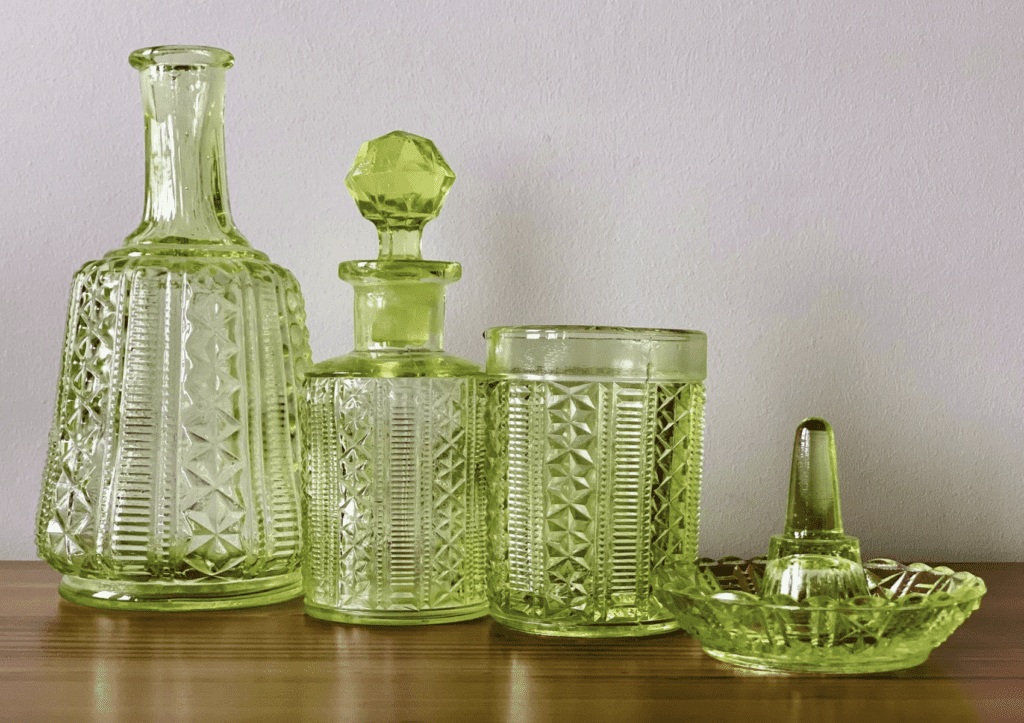Sodium Diuranate: Uranium in Czech Glass & Glazes
History & Overview
From the 1830s until the 1940s, uranium was used as a colorant in glass and ceramic glazes before the dangers of radioactivity were understood. It was known for its brilliant new colors that could withstand the high temperatures of glass production. The most common uranium glass and ceramic items are utilitarian and everyday objects, such as perfume bottles and tableware, and the most identifiable colors are eerie yellow-green and bright red-orange. The strength of the colors depends on the amount of uranium and the type and amount of additives that were mixed into the glass when it was made. Also, the glass can be either clear or opaque in appearance.
Uranium glass first appeared in the Czech factories of Josef Riedel who produced the glass commercially in the 1830s. In 1831, the glass was shown for the first time at the Prague Exhibition by the Northern Bohemian Harrach Glass Factory. It became very popular, and soon other European countries and the United States began producing their own versions of uranium glass and ceramics.
Some other names and types of uranium glass are Depression, Canary, Vaseline, and Burmese glass. They all share a similar yellow-green glow, but they originate from different locations and different time periods. For example, Canary glass has a more yellow tint and was produced in England starting from the late nineteenth century, and Depression glass was produced during the 1930s during the Great Depression.
Jáchymov:
Uranium has been used as a colorant for glass and glazes in the Czech Republic for a long time. During the Middle Ages, a pitchblende from uranium was extracted from Habsburg silver mines to color glass. Most of this mining happened in Joachimsthal, Bohemia which is now Jáchymov in the present day Czech Republic.
Much later, in 1789, Martin Heinrich Klaproth, a German chemist, discovered the element Uranium in Jáchymov. This discovery was the catalyst for the modern use of Uranium as a colorant in glass and ceramic glazes. In the 1890s, widespread mining on an industrial scale commenced in Jáchymov because of the increase in demand for uranium glass products.
RadioActivity:
Three types of natural background radiation are present in our everyday lives: cosmic, terrestrial, and artificial. Antiques containing Uranium emit low levels of terrestrial radiation for thousands of years and usually do not pose risks to an individual’s health if they are in good condition. Radiation emitted from uranium in ceramics glazes can be measured by a Geiger counter or by wrapping it with photographic film. For uranium in glass, it can also be detected by shining Ultraviolet light on it which makes the glass glow.
A fun fact about uranium glass and ceramic glazes is that working with objects that measure 0.02 mR/h for about five hours produces less radiation exposure than an x-ray at the dentist.
Safety:
While uranium glass and ceramic objects are beautiful, some precautions must be taken when handling these items to minimize health risks related to radioactivity. It is important to consider the intensity of radiation and exposure time when handling uranium glass and ceramics. For example, experts suggest wearing latex gloves when moving items identified as containing uranium, avoiding uranium glass or ceramic tableware for food or drink consumption, and not wearing uranium glass jewelry.
Did You Know?
Other toxic materials have been used throughout history for aesthetic purposes. Some examples are:
Cobalt Blue → Cobalt (II) Aluminate
First used in Chinese earthenware in 1400 AD, Cobalt blue rose to popularity as a pigment for ceramics in Europe after 1802. Similar to uranium glass, it was popular because of its ability to withstand the high temperatures of pottery production and the vibrant color it created.
Scheeler's Green and Emerald Green (aka Paris Green) → Arsenic
Scheeler’s Green was most popular in the Victorian era because of the emerald green hue it created. It was used as a color for wallpaper and women’s dresses and accessories.
Vermilion/ Cinnabar → Mercury
Most popular in the Middle Ages and the Renaissance, Vermilion was used to paint furniture, as lipstick and cheek rouge, and as a fabric colorant. Similar to uranium in glass and ceramic glazes, it has today been replaced with a much safer option.
White Lead (aka Lead White) → Lead
White Lead dates back to 300 BCE and is a product of corroding lead in vinegar. It was used as an oil paint for artists, was in some cosmetics, and used to paint ships in the eighteenth century.
Written by Anika Mueller-Hickler
“A Beginner’s Guide To Uranium Glass.” Decorative Collective, www.decorativecollective.com/blog/a-beginners-guide-to-uranium-glass#:~:text=Real%20uranium%20glass%20will%20glow,isn%27t%20always%20the%20case.
“Bohemian Glass: A History of Europe’s Treasured Crystal.” Mayfair Gallery, 11 Dec. 2020, www.mayfairgallery.com/blog/bohemian-glass-history-europes-treasured-crystal/.
Cianci, Lisa. “Problematic Colours.” Colour Theory Understanding and Working with Colour, RMIT Open Press, 23 Feb. 2023, rmit.pressbooks.pub/colourtheory1/chapter/problematic-colours/.
Cook, Annette. “Maryland Department of Planning Jefferson Patterson Park & Museum.” MDP, Jefferson Patterson Park and Museum, Oct. 2016, jefpat.maryland.gov/Pages/mac-lab/curators-choice/2016-curators-choice/2016-10-ghostly-glass-uranium-glass.aspx.
Jurda, Miroslav, and Miloslav Němec. “IOPscience.” Journal of Radiological Protection, IOP Publishing, 17 Jan. 2022, iopscience.iop.org/article/10.1088/1361-6498/ac0d40.
“Radioactivity in Antiques.” EPA, Environmental Protection Agency, www.epa.gov/radtown/radioactivity-antiques.
Strahan, Donna. “Uranium in glass, glazes and enamels: History, identification and handling.” Studies in Conservation, vol. 46, no. 3, 2001, pp. 181–195, https://doi.org/10.2307/1506809.
“Tales from the Atomic Age - Jáchymov: Cradle of the Atomic Age.” Museum of Radiation and Radioactivity, orau.org/health-physics-museum/articles/jachymov-cradle-of-the-atomic-age.html#:~:text=In%20a%20deep%20forest%20valley,Cradle%20of%20the%20Atomic%20Age.%22.
Tinkler, Andrew. “Poisonous Pigments of the Past.” The Oxford Student, 31 Mar. 2020, www.oxfordstudent.com/2020/02/20/poisonous-pigments-of-the-past/.
“Uranium Glass.” Uranium Glass Information from the Virtual Glass Museum, www.theglassmuseum.com/uranium.htm.




